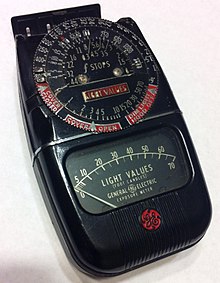Foot-candle
| Foot-candle | |
|---|---|
 General Electric Light Meter used in photography to measure light values in foot candles. | |
| General information | |
| Unit system | SAE units |
| Unit of | illuminance |
| Symbol | fc |
| Conversions | |
| 1 fc in ... | ... is equal to ... |
| SI derived unit | 10.76 lux |
| CGS units | 1.076×10−3 phots |
A foot-candle (sometimes foot candle; abbreviated fc, lm/ft2, or sometimes ft-c) is a non-SI unit of illuminance or light intensity. One foot-candle represents "the illuminance cast on a surface by a one-candela source one foot away."[citation needed] This unit is commonly used in lighting layouts in parts of the world where SAE units are used.
The unit foot-candle is defined as the amount of illumination the inside surface of a one-foot-radius sphere would be receiving if there were a uniform point source of one candela in the exact center of the sphere. Alternatively, it can be defined as the illuminance on a one-square foot surface of which there is a uniformly distributed flux of one lumen.
Thus one foot-candle is equal to one lumen per square foot or approximately 10.764 lux.[note 1] In practical applications, as when measuring room illumination, it is very difficult to measure illuminance more accurately than ±10%, and for many purposes it is quite sufficient to think of one foot-candle as about ten lux as is typically done in the lighting industry.
Use
In the lighting industry, foot-candles are a common unit of measurement used to calculate adequate lighting levels of workspaces in buildings or outdoor spaces. Foot-candles are also commonly used in the museum and gallery fields, where lighting levels must be carefully controlled to conserve light-sensitive objects such as prints, photographs, and paintings, the colors of which fade when exposed to bright light for a lengthy period.
In the motion picture cinematography field, incident light meters are used to measure the number of foot-candles present, which are used to calculate the intensity of motion picture lights, allowing cinematographers to set up proper lighting-contrast ratios when filming.
Since light intensity is the primary factor in the photosynthesis of plants, horticulturalists often measure and discuss optimum intensity for various plants in foot-candles.
Examples
Full, unobstructed sunlight has an intensity of approximately 10,000 fc.[1] An overcast day will produce an intensity of around 100 fc. The intensity of light near a window can range from 100 to 5,000 fc, depending on the orientation of the window, time of year and latitude.
Indoor lighting for residences seeks to provide 5-40 fc for general spaces and 70-90 fc for work spaces.[2]
Lighting requirements for commercial spaces range from 5 fc for storage spaces to 200 fc for visually intensive work.[1]
Notes
- ^ One lumen per square foot is equal to 0.3048−2 lumens per square meter. Since illuminance follows the inverse-square law a source that is farther away casts less illumination than one that is close, so one lux is less illuminance than one foot-candle.
See also
- Photometry (optics) for more on the measurement of light.
External links
- ^ a b "How Much Light Is Enough? Footcandle Recommendations". Retrieved 2018-04-18.
- ^ "How much light do I need?". Retrieved 2018-04-18.
